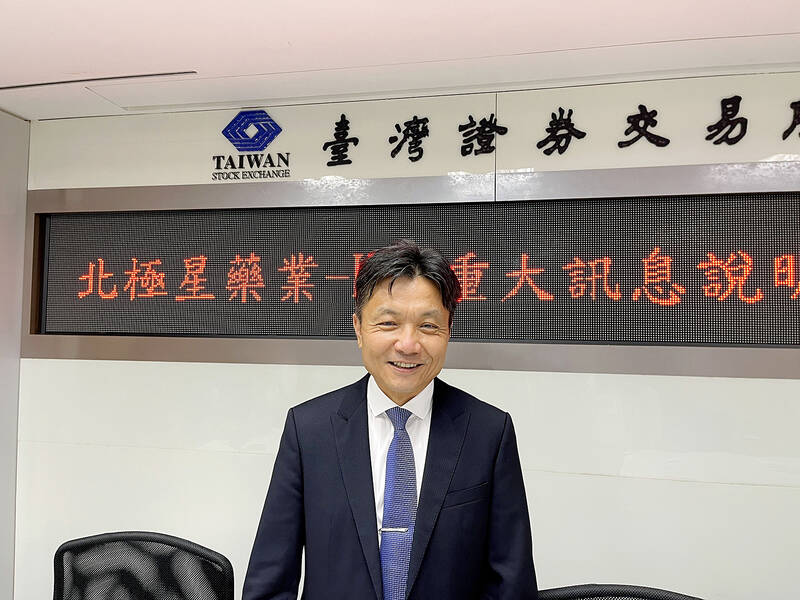Polaris Group (北極星藥業集團) yesterday said that phase 3 clinical trials for its mesothelioma treatment ADI-PEG 20 has been successful, adding that it plans to apply next year for marketing approval with the US Food and Drug Administration (FDA).
The trials showed that two main test gauges reached statistical significance, Polaris said, referring to overall survival (OS) — the time a patient survives from the beginning of treatment — and progression-free survival (PFS) time — the time a patient’s cancer does not worsen from the beginning of treatment.
The median OS time for the 125 participants treated with ADI-PEG 20 was 9.3 months, 21.4 percent higher than 7.66 months for the 124 participants in the control group, Polaris said.

Photo: CNA
The median PFS time was 6.11 months, compared with 5.59 months for the control group, it said.
The trials showed that 98.4 percent and 8.8 percent of all participants in the test group reported adverse events and serious adverse effects respectively, lower than 99.2 percent and 9.7 percent in the control group, it added.
“The small difference between the ratios of people with adverse effects in the two groups signifies the safety of ADI-PEG 20,” it said.
The trials were conducted in 38 hospitals in five countries: Taiwan, the US, the UK, Australia and Italy, it said.
As Polaris in February received the FDA’s fast-track designation, its application for marketing approval would be expedited, Polaris chairman Howard Chen (陳鴻文) told a news conference, adding that the company plans to submit the application at the beginning of next year.
Even though the number of people with mesothelioma is not high, totaling 38,000, the company is confident about the drug’s sales prospects, Chen said.
As Polaris developed ADI-PEG 20 with a metabolism-based strategy that depletes arginine, which causes stress and cytotoxicity in tumors, it could continue to try combining ADI-PEG 20 with other chemotherapy drugs for treating other kinds of cancer, the company said.
Polaris said that cumulative revenue in the first eight months of this year plunged 40 percent year-on-year to NT$5.55 million (US$176,527).

Taiwanese suppliers to Taiwan Semiconductor Manufacturing Co. (TSMC, 台積電) are expected to follow the contract chipmaker’s step to invest in the US, but their relocation may be seven to eight years away, Minister of Economic Affairs J.W. Kuo (郭智輝) said yesterday. When asked by opposition Chinese Nationalist Party (KMT) Legislator Niu Hsu-ting (牛煦庭) in the legislature about growing concerns that TSMC’s huge investments in the US will prompt its suppliers to follow suit, Kuo said based on the chipmaker’s current limited production volume, it is unlikely to lead its supply chain to go there for now. “Unless TSMC completes its planned six

Power supply and electronic components maker Delta Electronics Inc (台達電) yesterday said second-quarter revenue is expected to surpass the first quarter, which rose 30 percent year-on-year to NT$118.92 billion (US$3.71 billion). Revenue this quarter is likely to grow, as US clients have front-loaded orders ahead of US President Donald Trump’s planned tariffs on Taiwanese goods, Delta chairman Ping Cheng (鄭平) said at an earnings conference in Taipei, referring to the 90-day pause in tariff implementation Trump announced on April 9. While situations in the third and fourth quarters remain unclear, “We will not halt our long-term deployments and do not plan to

‘SHORT TERM’: The local currency would likely remain strong in the near term, driven by anticipated US trade pressure, capital inflows and expectations of a US Fed rate cut The US dollar is expected to fall below NT$30 in the near term, as traders anticipate increased pressure from Washington for Taiwan to allow the New Taiwan dollar to appreciate, Cathay United Bank (國泰世華銀行) chief economist Lin Chi-chao (林啟超) said. Following a sharp drop in the greenback against the NT dollar on Friday, Lin told the Central News Agency that the local currency is likely to remain strong in the short term, driven in part by market psychology surrounding anticipated US policy pressure. On Friday, the US dollar fell NT$0.953, or 3.07 percent, closing at NT$31.064 — its lowest level since Jan.

The New Taiwan dollar and Taiwanese stocks surged on signs that trade tensions between the world’s top two economies might start easing and as US tech earnings boosted the outlook of the nation’s semiconductor exports. The NT dollar strengthened as much as 3.8 percent versus the US dollar to 30.815, the biggest intraday gain since January 2011, closing at NT$31.064. The benchmark TAIEX jumped 2.73 percent to outperform the region’s equity gauges. Outlook for global trade improved after China said it is assessing possible trade talks with the US, providing a boost for the nation’s currency and shares. As the NT dollar